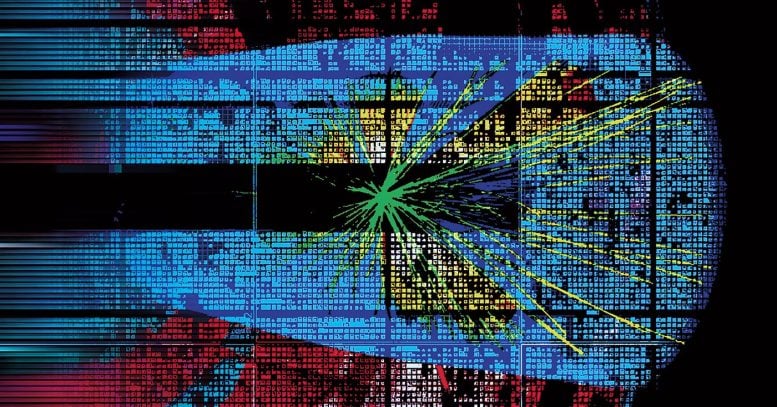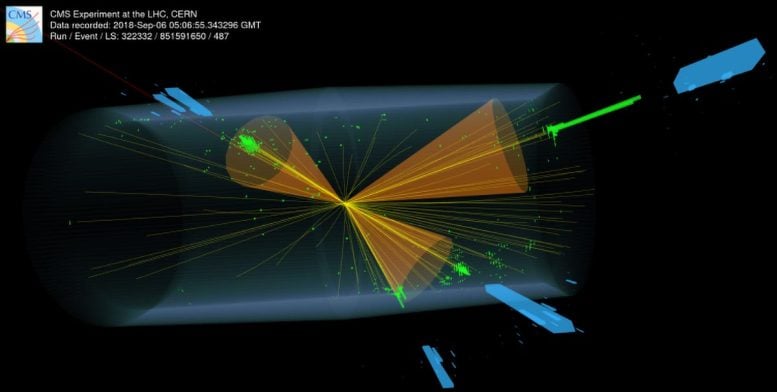
Posted on 07/05/2024 5:59:14 AM PDT by Red Badger

The ATLAS and CMS collaborations are using state-of-the-art machine learning techniques to search for exotic-looking collisions that could indicate new physics. Credit: S Sioni/CMS-PHO-EVENTS-2021-004-2/M Rayner
============================================================================
Artificial intelligence is revolutionizing how new particles are detected in LHC experiments. By training AI to recognize and differentiate between typical and atypical jets, researchers can identify potential new physics hidden within particle collisions. Recent advancements were highlighted at a physics conference, showing the progress and potential of these AI applications.
One of the primary goals of the Large Hadron Collider (LHC) experiments is to look for signs of new particles, which could explain many of the unsolved mysteries in physics. Often, searches for new physics are designed to look for one specific type of new particle at a time, using theoretical predictions as a guide. But what about searching for unpredicted – and unexpected – new particles?
Sifting through the billions of collisions that occur in the LHC experiments without knowing exactly what to look for would be a mammoth task for physicists. So, instead of combing through the data and looking for anomalies, the ATLAS and CMS collaborations are letting artificial intelligence (AI) streamline the process.
AI Advancements in Particle Detection
At the Rencontres de Moriond conference on March 26, physicists from the CMS collaboration presented the latest results obtained by using various machine learning techniques to search for pairs of “jets.” These jets are collimated sprays of particles originating from strongly interacting quarks and gluons. They are particularly difficult to analyze, but they could be hiding new physics.

AI Detected Highly Anomalous CMS Event Display
Event display of one of the CMS events determined by the AI algorithm to be highly anomalous and therefore potentially coming from a new particle. Credit: CMS collaboration
==================================================================
Techniques in AI Training for Physics
Researchers at ATLAS and CMS use several strategies to train AI algorithms in their searches for jets. By studying the shape of their complex energy signatures, scientists can determine what particle created the jet. Using real collision data, physicists at both experiments are training their AI to recognise the characteristics of jets originating from known particles. The AI is then able to differentiate between these jets and atypical jet signatures, which potentially indicate new interactions. These would show up as an accumulation of atypical jets in the data set.
Another method involves instructing the AI algorithm to consider the entire collision event and look for anomalous features in the different particles detected. These anomalous features may indicate the presence of new particles. This technique was demonstrated in a paper released by ATLAS in July 2023, which featured one of the first uses of unsupervised machine learning in an LHC result. At CMS, a different approach involves physicists creating simulated examples of potential new signals and then tasking the AI with identifying collisions in the real data that are different to regular jets but resemble the simulation.
Machine Learning’s Impact on Particle Physics
In the latest results presented by CMS, each AI training method exhibited varying sensitivities to different types of new particles, and no single algorithm proved to be the best. The CMS team was able to limit the rate of production of several different types of particles that produce anomalous jets. They were also able to show that the AI-led algorithms significantly enhanced the sensitivity to a wide range of particle signatures in comparison to traditional techniques.
These results show how machine learning is revolutionizing the search for new physics. “We already have ideas about how to further improve the algorithms and apply them to different parts of the data to search for several kinds of particles,” says Oz Amram, from the CMS analysis team.
The Biden Particle. It suddenly freezes up when it collides with reality................
You have a gift….🤣
Not really a breakthrough. Machine learning techniques have been used for years at CERN. For example, the image included in this article is dated September 6, 2018.
Next level science and engineering AI is going to literally change everything. It will be able to make astounding and rapid advances in science beyond what the average person is able to accept right now. We are moving into an unprecedentedly dangerous era. Putin seems to understand this. Biden has barely mentioned the subject, likely because he is so old and out of touch. https://fortune.com/2017/09/04/ai-artificial-intelligence-putin-rule-world/
The collider is really a big waste of money. No ground breaking physics discoveries have come from it. In fact there hasn’t been much of anything in physics for a long time. Except the endless crowing for more grants.
Didn’t the confirm the existence of the Higgs boson, the so-called “God Particle”?.........
Yup
The Biden Particle.
Either that or it splits off in a whole new direction...
Ho,Ho,HO! Merry Forth of July !
So they say. However verifying a theory is not coming up with new answers or solving long term problems. Like the problem of why the atomic models in the chem department are different than the physics department.
Disclaimer: Opinions posted on Free Republic are those of the individual posters and do not necessarily represent the opinion of Free Republic or its management. All materials posted herein are protected by copyright law and the exemption for fair use of copyrighted works.